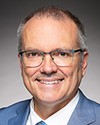Thank you very much, Madam Chair.
I would like to discuss a few points concerning Mr. Badawey's proposal.
First of all, in light of the fact that the Minister of Infrastructure and Communities has already announced that he is currently working on phase two of the infrastructure investment plan, I think it would be very important to adopt a schedule for our work. We have to see to it that our work serves those who will pay according to what we will recommend. Since sums of money come from one pocket and the ideas will probably come from another, the ideas have to be ready when people are ready to spend. I think it would be important to draw up a timeline or, at least, make sure we complete the first part of this analysis as quickly as possible.
Secondly, I wonder if Mr. Badawey would agree to amend his motion slightly in order to align our work expressly with the infrastructure projects and the infrastructure plan. We should mention that all of this is being done in the context of that project, to send a clear signal to government authorities that we are doing this work quickly because we want transportation to be a priority consideration in investment projects. If that could be included in the motion, I could support it more easily.
Thirdly, Mr. Hardie, you had proposed that we approach this sector and this study in light of the country's economy. However, we must not forget that in developing the country's economy, we can help grow the wealth of Canadian citizens. We can also enhance growth on the social side. We are basing our work on the economy, but we should not forget that there are also repercussions in the regions and not only in the large centres.
It is like the question I put to Mr. Dee. We should not only focus on the big network. How can the small network and small communities be integrated into this potential national transport strategy?
To begin this study, I think it would be important to see what has been done elsewhere. It would be interesting to see how a national transportation strategy can inflect infrastructure investments. As Mr. Dee said, a national transport strategy must continually be changing. We want to avoid what Ms. Block identified: establishing a strategy every 10 years means a static strategy.
How can we ensure that we use past experience to see what was done well and what was done poorly? We should not redo the same things poorly, or redo the same things, period. As Ms. Duncan mentioned earlier, we should not redo things that have already been done. I think it is important that our first meetings on this topic allow us to clarify the direction of our study and the work of the committee.

